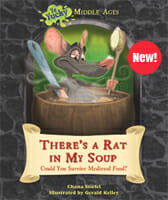 Many children are reluctant to choose non-fiction books. Series such as Chana Stiefel’s Ye Yucky Middle Ages may reverse this trend. In exchange for an interview and honest review, Chana graciously sent me two books- Sweaty Suits of Armor: Could You Survive Being a Knight? and There’s a Rat in my Soup: Could You Survive Medieval Soup? I was immediately intrigued by the titles and the book covers.
Many children are reluctant to choose non-fiction books. Series such as Chana Stiefel’s Ye Yucky Middle Ages may reverse this trend. In exchange for an interview and honest review, Chana graciously sent me two books- Sweaty Suits of Armor: Could You Survive Being a Knight? and There’s a Rat in my Soup: Could You Survive Medieval Soup? I was immediately intrigued by the titles and the book covers.
If you would like to read one of the Ye Yucky Middle Ages books, consider leaving a comment on this blog. Then you will be eligible for the book giveaway drawing on June 22.
This chapter book series is well organized. The contents page spells out the topics being covered. Additional resources include a glossary of words to know and lists for additional print and Internet resources. A red font distinguishes words that are defined in the glossary. Colorful graphics and whimsical illustrations create a kid-friendly tone.
Sweaty Suits of Armor: Could You Survive Being a Knight?
Despite its short length, this book is filled with an abundance of facts about the Middle Ages and knights. Chana doesn’t waste any time dispelling the glamorous myths associated with knighthood. She boldly states, “Knighthood was often sweaty, dirty, and bloody.” (Page 6) After making that assertion, she provides rich details that support the harsh realities of the years of mandatory training and the hazards associated with becoming a knight. Included are topics that sometimes are overlooked such as the exorbitant expense of the equipment and the fact that not everyone who went through the mandated training became a knight.
Chana adeptly compares and contrasts life today with life during the Middle Ages. These comparisons help modern readers to gain a better perspective. For example, a suit of armor weighed approximately 44 to 65 pounds while today’s American solider carries 60-70 pounds of gear.
Any middle level reader seeking information regarding medieval knights will find this book an excellent resource.
There’s a Rat in My Soup: Could You Survive Medieval Food?
One needs a good sense of humor and a strong stomach to cope with some of the recipes that Chana shares in this book. Would anyone ever imagine that medieval cooks used all the parts of an animal and had a propensity for serving life animals? Readers will be equally disgusted to learn the acceptable levels of uncleanliness. It was not out of the ordinary to find “beer, grease, bones, spit, and poop from dogs, cats and rats” under the table.
Chana describes the differences between the wealthy who routinely gorged themselves during massive feasts and the poor who ate a more simple diet. Every day ingredients such as flour were a luxury for the less fortunate. Grinding their wheat and baking the bread were expensive processes.
Food hazards affected all socio-economic classes. The ill effects were endless due to ignorance and a lack of refrigeration. Food availability became scarce during times of drought, excessive rain, and when the castle or community were under siege.
Being aware of these medieval dangers helps readers appreciate our modern ways of food distribution, preservation, and preparation.
Anyone interested in medieval times or the history of food will be fascinated by this book.
Book Giveaway
If you leave a comment on this blog by Sunday, June 22, you will be eligible for a book giveaway. The randomly selected winner will be sent an autographed copy of Castle Stinketh: Could You Survive Living in a Castle?
Related Blogs:
Q & A With Laura DeBruce, Author of The Riddle of Prague
Q & A With Frank Nappi, Mickey Tussler Series
Sandra’s Bio


Leave a Reply
You must be logged in to post a comment.